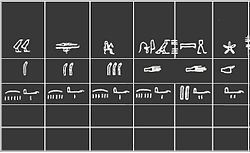Digit (unit)


The digit or finger is an ancient and obsolete non-SI unit of measurement of length. It was originally based on the breadth of a human finger.[1] It was a fundamental unit of length in the Ancient Egyptian, Mesopotamian, Hebrew, Ancient Greek and Roman systems of measurement.
In astronomy a digit is one twelfth of the diameter of the sun or the moon.[2]
History[]
Ancient Egypt[]
The digit, also called a finger or fingerbreadth, is a unit of measurement originally based on the breadth of a human finger. In Ancient Egypt it was the basic unit of subdivision of the cubit.[1]
On surviving Ancient Egyptian cubit-rods, the royal cubit is divided into seven palms of four digits or fingers each.[3] The royal cubit measured approximately 525 mm,[4] so the length of the ancient Egyptian digit was about 19 mm.
| Name | Egyptian name | Equivalent Egyptian values | Metric equivalent | ||||
|---|---|---|---|---|---|---|---|
| Royal cubit |
|
7 palms or 28 digits | 525 mm | ||||
| Fist | 6 digits | 108 mm | |||||
| Hand | 5 digits | 94 mm | |||||
| Palm |
|
4 digits | 75 mm | ||||
| Digit |
|
1/4 palm | 19 mm |
Mesopotamia[]
In the classical Akkadian Empire system instituted in about 2250 BC during the reign of Naram-Sin, the finger was one-thirtieth of a cubit length. The cubit was equivalent to approximately 497 mm, so the finger was equal to about 17 mm. Basic length was used in architecture and field division.
| Unit | Ratio | Metric equivalent |
Sumerian | Akkadian | Cuneiform |
|---|---|---|---|---|---|
| grain | 1/180 | 2.8 mm | še | uţţatu |